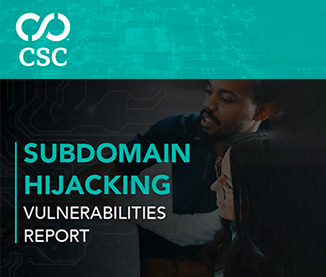

Brand Protection |
Sponsored by |

|



 DOTZON's 2025 study analyzes over 410 corporate dotBrands to reveal how companies strengthen digital identities through custom top-level domains. Audi retains first place, while newcomers like CRS and rising performers such as Schwarz demonstrate growing strategic use.
DOTZON's 2025 study analyzes over 410 corporate dotBrands to reveal how companies strengthen digital identities through custom top-level domains. Audi retains first place, while newcomers like CRS and rising performers such as Schwarz demonstrate growing strategic use.
 As artificial intelligence reshapes how users navigate the web, domain names may undergo explosive growth, potentially reaching tens of billions. A new infrastructure of trusted digital identities could become essential for AI agents.
As artificial intelligence reshapes how users navigate the web, domain names may undergo explosive growth, potentially reaching tens of billions. A new infrastructure of trusted digital identities could become essential for AI agents.
 Many previous pieces of research have focused on the desirability of a comprehensive scoring system, to be used for ranking results identified as part of a brand-protection solution, according to their potential level of threat. Such scoring systems offer the capability for identifying prioritised targets for further analysis, content tracking or enforcement actions.
Many previous pieces of research have focused on the desirability of a comprehensive scoring system, to be used for ranking results identified as part of a brand-protection solution, according to their potential level of threat. Such scoring systems offer the capability for identifying prioritised targets for further analysis, content tracking or enforcement actions.
 As published on June 24, 2025, it is with no surprise that the AFNIC was renewed as the backend registry provider of the .PARIS new generic Top-Level Domain. What caught my attention in the announcement was this paragraph: “Afnic’s remit will also be expanded to include communication and promotion of the .paris TLD, as well as the development of initiatives designed to increase its adoption by businesses and private individuals.”
As published on June 24, 2025, it is with no surprise that the AFNIC was renewed as the backend registry provider of the .PARIS new generic Top-Level Domain. What caught my attention in the announcement was this paragraph: “Afnic’s remit will also be expanded to include communication and promotion of the .paris TLD, as well as the development of initiatives designed to increase its adoption by businesses and private individuals.”
 The ability to rank results according to the level of threat they pose (based on factors such as, for example, the extent to which a webpage relates to a brand of interest) is a key component of many brand protection services. The prioritisation process has a number of purposes, including the identification of: (a) priority targets for further analysis; (b) candidates for content tracking (i.e. regular reinspection of content or configuration, and the generation of an alert if high-concern findings are identified) - as may be appropriate in cases where a domain name presents a high potential level of risk but is not currently associated with any live site content; and (c) priority targets for enforcement actions.
The ability to rank results according to the level of threat they pose (based on factors such as, for example, the extent to which a webpage relates to a brand of interest) is a key component of many brand protection services. The prioritisation process has a number of purposes, including the identification of: (a) priority targets for further analysis; (b) candidates for content tracking (i.e. regular reinspection of content or configuration, and the generation of an alert if high-concern findings are identified) - as may be appropriate in cases where a domain name presents a high potential level of risk but is not currently associated with any live site content; and (c) priority targets for enforcement actions.
 The introduction of GDPR in 2018, and the subsequent tightening of privacy regulations around the world, was a necessary step toward protecting user data. Consumers gained critical rights over their personal information, and companies were forced to adopt stronger standards for how they collect, store, and use that data. However, one unintended consequence has been the erosion of access to domain registration information once easily available through WHOIS databases.
The introduction of GDPR in 2018, and the subsequent tightening of privacy regulations around the world, was a necessary step toward protecting user data. Consumers gained critical rights over their personal information, and companies were forced to adopt stronger standards for how they collect, store, and use that data. However, one unintended consequence has been the erosion of access to domain registration information once easily available through WHOIS databases.
 When major events like the Super Bowl are on the horizon, cybercriminals exploit public trust by creating fraudulent domains for fake betting sites, phishing, and malware distribution. CSC's research into top online sportsbooks highlights the hidden risks of dormant domains, which, though inactive, can quickly be repurposed for cyber attacks. Overlooked yet dangerous, these domains play a key role in impersonation, misinformation, and scams targeting event-driven traffic, underscoring the need for continuous monitoring of lookalike, dropped, re-registered, and newly registered domains.
When major events like the Super Bowl are on the horizon, cybercriminals exploit public trust by creating fraudulent domains for fake betting sites, phishing, and malware distribution. CSC's research into top online sportsbooks highlights the hidden risks of dormant domains, which, though inactive, can quickly be repurposed for cyber attacks. Overlooked yet dangerous, these domains play a key role in impersonation, misinformation, and scams targeting event-driven traffic, underscoring the need for continuous monitoring of lookalike, dropped, re-registered, and newly registered domains.
 You may have read our previous blog about the pending reduction of digital certificate life cycles to just 90 days. This past weekend, the issue gained momentum at the Certification Authority Browser Forum when more detail was discussed following the proposed ballot to set a timeline for shorter lifetime certificates by Apple. This creates real urgency for organizations of all sizes to seriously consider and implement automation into their certificate life cycle management.
You may have read our previous blog about the pending reduction of digital certificate life cycles to just 90 days. This past weekend, the issue gained momentum at the Certification Authority Browser Forum when more detail was discussed following the proposed ballot to set a timeline for shorter lifetime certificates by Apple. This creates real urgency for organizations of all sizes to seriously consider and implement automation into their certificate life cycle management.
 One major element of many brand-protection programmes is the use of an algorithm to sort the findings identified through monitoring, according to their relevance or level of potential threat. This prioritisation process offers a number of benefits, including the identification of priority targets for further analysis, content tracking, or enforcement.
One major element of many brand-protection programmes is the use of an algorithm to sort the findings identified through monitoring, according to their relevance or level of potential threat. This prioritisation process offers a number of benefits, including the identification of priority targets for further analysis, content tracking, or enforcement.
 As counterfeit networks grow more elusive, AI-driven clustering could revolutionize brand protection. By linking disparate findings, identifying serial infringers, and enabling bulk enforcement, AI offers a smarter approach to monitoring and takedown efforts. Yet, challenges remain - from data reliability to analyzing complex content. Companies that master AI-driven clustering may gain a significant advantage in the fight against brand abuse.
As counterfeit networks grow more elusive, AI-driven clustering could revolutionize brand protection. By linking disparate findings, identifying serial infringers, and enabling bulk enforcement, AI offers a smarter approach to monitoring and takedown efforts. Yet, challenges remain - from data reliability to analyzing complex content. Companies that master AI-driven clustering may gain a significant advantage in the fight against brand abuse.
The global debate over Internet privacy and security took center stage in a webinar hosted by CircleID in partnership with the Edgemoor Research Institute. The event marked the first in a series exploring the delicate balance between safeguarding personal data and ensuring legitimate access to domain name registration details. As governments, cybersecurity experts, law enforcement, and intellectual property holders grapple with the evolving regulatory landscape, Project Jake seeks to establish a framework that prioritizes policy clarity, efficiency, and adaptability.
 The UnregisteredGems.com series of articles explores a range of techniques to filter and search through the universe of unregistered domain names, in order to find examples which may be compelling candidates for entities looking to select a new brand name (and its associated domain). The previous instalment of the series looked at the categorisation of candidate names according to the phonetic characteristics of its constituent consonants, using a simple one-to-one mapping between each consonant and a corresponding phonetic group.
The UnregisteredGems.com series of articles explores a range of techniques to filter and search through the universe of unregistered domain names, in order to find examples which may be compelling candidates for entities looking to select a new brand name (and its associated domain). The previous instalment of the series looked at the categorisation of candidate names according to the phonetic characteristics of its constituent consonants, using a simple one-to-one mapping between each consonant and a corresponding phonetic group.
 The initial instalment of my recent series of articles on domain name discovery1 considered the use of phonotactic analysis - that is, the measure of the similarity of a string to the 'corpus' of other words in a language - to identify available unregistered candidate domains which may be of interest for potential brandability.
The initial instalment of my recent series of articles on domain name discovery1 considered the use of phonotactic analysis - that is, the measure of the similarity of a string to the 'corpus' of other words in a language - to identify available unregistered candidate domains which may be of interest for potential brandability.
 The cybersecurity landscape in 2024 has been characterised by unprecedented complexity and rapidly evolving threats, presenting significant challenges for organisations across all sectors. As the digital attack surface expands and threat actors employ increasingly sophisticated techniques, domain security has emerged as a critical component of a robust cybersecurity strategy.
The cybersecurity landscape in 2024 has been characterised by unprecedented complexity and rapidly evolving threats, presenting significant challenges for organisations across all sectors. As the digital attack surface expands and threat actors employ increasingly sophisticated techniques, domain security has emerged as a critical component of a robust cybersecurity strategy.
 For any entity looking to launch a new company or other initiative, a primary requirement is often the selection of an appropriate brand name and the acquisition of a relevant associated domain name. In light of the increasing shortage of short, unregistered memorable names on popular domain name extensions (TLDs), many organisations are choosing to adopt novel or invented brand names and/or consider the use of alternative TLDs.
For any entity looking to launch a new company or other initiative, a primary requirement is often the selection of an appropriate brand name and the acquisition of a relevant associated domain name. In light of the increasing shortage of short, unregistered memorable names on popular domain name extensions (TLDs), many organisations are choosing to adopt novel or invented brand names and/or consider the use of alternative TLDs.
 Amazon Gets FCC Approval to Deploy Its Project Kuiper Broadband Satellites
Amazon Gets FCC Approval to Deploy Its Project Kuiper Broadband SatellitesThe Chinese market is the second largest in the world with an estimated GDP of $18 trillion. Over the past few decades, it has grown to be a powerhouse of manufacturing and technology. This has been coupled with a large increase in the internet penetration that now stands at 76%, which for a country of 1.4 billion people is a significant number of people online. more
This year marks the fifth annual release of CSC's "Domain Security Report," which continues to shed light on the evolving landscape of domain security among Global 2000 companies. more
The journey towards widespread Cloud adoption has significantly impacted domain name system (DNS) management practices. Initially, businesses operated their own data centers, however the shift towards external hosting providers has introduced complexities and increased the potential for DNS record mismanagement, and therefore, subdomain vulnerability. more
Last month, Stephanie Driver, CSC's marketing manager, spoke with Global Director of Security Services Mark Flegg and discussed the Network and Information Security Directive (NIS2) 2022, which comes into force in October 2024. more
In recent news, more than 13,000 subdomains of brands were hijacked for a large spam campaign that "leverages the trust associated with these domains to circulate spam and malicious phishing emails by the millions each day, cunningly using their credibility and stolen resources to slip past security measures." more
This month, Stephanie Driver, CSC's marketing manager, spoke with Patrick Hauss, head of Corporate Development and Strategic Alliances EMEA, about the Internet Corporation for Assigned Names and Numbers (ICANN) Registration Data Request Service (RDRS) as part of an ongoing a series of interviews with CSC's Digital Brand services business experts, where we talk about industry issues across cybersecurity, domains, brand protection, and fraud protection. more
CSC, an enterprise-class domain registrar and world leader in mitigating domain security, domain name system (DNS), and digital brand threats, today announces its partnership with NetDiligence®, a leader in cyber risk readiness and response solutions for the cyber insurance industry. more